|
General Sewing Instructions
Copyright ©1998-2000 Leena Lähteenmäki,
Järvenpää
Preshrinking the fabric
When you buy your fabric, ask how much it will shrink when
washed. In all cases, when the fabric is washable and when you are not
sure that the fabric won't shrink, it is safe to wash and iron it before
cutting. Don't forget to preshrink lining as well.
HINT : If you do not want to preshrink
the fabric you can check the amount the fabric shrinks horizontally
and vertically by wetting and ironing a small piece of it and resize
your patterns accordingly using the PatternMaker editing tools.
To get instructions of how to calculate the needed scaling
factor, refer to the sewing  instructions for women's lingerie.
Scaling patterns is a frequent task for garments sewn of elastic fabrics.
instructions for women's lingerie.
Scaling patterns is a frequent task for garments sewn of elastic fabrics.
Cutting the pattern pieces
Cut pattern pieces on folded fabric, right side of the
fabric folded inwards. Make the necessary marks on the fabric with
chalk or pencil.
If the fabric is plaid, striped or checkered, align the
hem lines at the same point on the repeating pattern. For sleeves, the
repeating pattern should match where the bottom of the armscye and bottom
of sleeve cap meet. Vertical centerline of sleeve should be placed at
a vertical stripe or at center of a plaid square. Jacket, blouse and dress
front center should be placed the same way.
Transfer notch marks from your pattern to the fabric by
cutting snips (depth 0.5 mm /1/8") into seam allowances. When
joining garment pieces, place corresponding notch marks in the two pieces
together.
HINT: If the fabric is slippery spread out newspaper between
the fabric and the table. It will keep the fabric in place when you
cut the garment pieces from it. Be sure not to let the printing ink
from the newspaper to stain your fabric. If this would be the case use
another paper.
HINT : Do not use pins to attach the patterns to the fabric.
Use Scotch tape in stead. Position the tape pieces half on the fabric
and half on the patterns where you want to and cut through the tapes.
Normally you do not have to remove the tape pieces after cutting, the
pieces which are on the patterns do not hurt them and the pieces on
the fabric are outside the garment pieces.
Interfacing
Cut and iron interfacing to under collars, facings, waist
bands, slit facings, blouse and shirt button extensions and sleeve cuffs.
Using interfacing at jacket's hem seam allowance makes get a neat hem.
If you sew a patch pocket and don't line it, attach interfacing
to it also.
Always trim interfacing to eliminate the seam allowances
Cutting the lining
Cut lining along with garment patterns without space for
facings (but remember to add seam allowances) and hem seam allowances.
Do not cut lining for collars. Lining fabric usually is not as elastic
as garment fabric, so cut it with about 1/8 inch (0.3 cm) wider
seam allowances than for the garment pieces.
Basting
Use the longest possible machine stitches for basting.
It is quick and the stitches can easily be removed.
HINT : In some cases you can use two-sided fusible interfacing
for basting purposes. If you need to keep two garment pieces on top
of each other and prevent them from shifting when you sew - like pocket
on the garment, put small pieces of two-sided fusible interfacing under
the pocket piece and iron the pocket lightly. After you have sewn the
pocket in place, remove the interfacing between the pocket and the garment.
Finishing the garment
You will get the best result if you always press seams
and darts as you sew. First iron seams or darts flat without turning
them to either direction. Then press them towards center, side seam
towards front. Two-piece sleeve seams are both pressed towards shoulder
mark. Use a steam iron. If you press seams from right side
of the fabric, use pressing cloth if necessary.
Edgestitching gives a well-finished look to garment, but
only if it is straight and even. Long stitches of 1/4 inch (4-5
mm) look best in edgestitching. Sew edgestitching only after you
have ironed the seam.
To tame facings at garment edges use technique understitching.
It prevents the seamlines from showing on the outside of the garment and
keep the seam allowances in the desired position. Refer to  explanations
of used terminology at the end of these instructions.
explanations
of used terminology at the end of these instructions.
Bound edge
 Here
is an easy way to sew a professional looking bound edges to neck
openings, sleeve cuffs and hems of casual garments as well as to lingerie
and outdoor garments. In the example illustrated here the edging is sewn
to the neck opening of a sweater Here
is an easy way to sew a professional looking bound edges to neck
openings, sleeve cuffs and hems of casual garments as well as to lingerie
and outdoor garments. In the example illustrated here the edging is sewn
to the neck opening of a sweater
Cut a strip of fabric 4 times as wide as the desired finished
width of the edging and approximately as long as the edge to which it
is to be connected. In the picture the finished width of the edging is
1 cm. So the width of the fabric strip in this case is 4 cm.
 Fold
the fabric strip lengthwise in two, wrong side inside, and iron. Sew it
to the wrong side of the neck opening raw edges matching. Stretch
the edging a bit when sewing. Fold
the fabric strip lengthwise in two, wrong side inside, and iron. Sew it
to the wrong side of the neck opening raw edges matching. Stretch
the edging a bit when sewing.
Start sewing 5 cm from the CB of the neck opening and leave
another 1 cm of edging free (for the CB seam of the edging). Stop sewing
5 cm from the CB of the neckline and leave 1 cm for seam allowance. Sew
the CB seam of the edging. Fold the edging in two at the CB of the neck
as elsewhere and sew the rest of the connection seam.
  Trim
seam allowance to half. Open the seam well by iron the edging and the
seam allowances away from each other. Turn the edging around the edge
to the right side of the garment along the stitch line. Be sure not to
leave the stitch line visible at the right side of the garment. Edgestitch
along the folded edge. Sew slowly. Only even edgings with straight stitch
lines are neat. Trim
seam allowance to half. Open the seam well by iron the edging and the
seam allowances away from each other. Turn the edging around the edge
to the right side of the garment along the stitch line. Be sure not to
leave the stitch line visible at the right side of the garment. Edgestitch
along the folded edge. Sew slowly. Only even edgings with straight stitch
lines are neat.
If you find it difficult to sew such a narrow edging - especially
if your fabric is thick - you can try cutting the fabric strip a bit wider,
for instance 6 times of the desired finished width of the edging (in the
example garment it would be 6 cm. It is easier to turn a wider edging
around the edge and the connection seam can be left well inside of the
garment. In the sample garment the fabric strip for the edging at the
neck opening is 4 cm and at the sleeve cuffs 6 cm.
Attaching zipper to pants or skirt
Sew seam to the point where zipper begins and continue
zipper's full length with basting (picture 1). Press the seam open.
Remove basting stitches. Mark front (or back) centerline with basting.
Fold one seam allowance of zipper placket at about 1/4
inch (0.5 cm) distance from front (or back) centerline) (picture 2a).
Sew one zipper edge under the extended seam allowance (picture 2b).


Close zipper placket temporarily with pins on right side
of garment (picture 3).
On wrong side pin other zipper edge flat on seam allowance
(picture 4). Make certain that the zipper is straight and lies flat
at an even distance from edges of seam allowance.
Remove pins from right side. Sew from wrong side
through all thicknesses, across bottom (picture 4) and up the pinned edge
of zipper near zipper teeth.

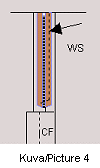

If you want to, you can sew a second row of stitches one
presser foot's distance from the first one picture 5). If you are
making jeans or other pants that need to be very strong, strengthen bottom
of zipper placket with tight zigzag (barrack) on right side.
If you want to create a LESS NOTICEABLE ZIPPER PLACKET,
sew zipper directly onto garment seam, placing zipper upside down on a
basted seam on wrong side of garment. The distance between the seam
and the zipper stitching is the width of the presser foot. Basting
is removed after sewing. This kind of a zipper is good for a dress
back seam and is also widely used in skirts.
Attaching waistband to skirt or pants



Overlock edges of waistband. Fold waistband lengthwise,
right side in and press. Unfold waistband and sew its one horizontal
edge to garment, right sides together (Picture 1). Space for button
and buttonhole extends beyond center front mark at each end of the band.
Garment's waist should always be slightly larger than waistband.
Easestitch garment waist to fit waistband.
Fold waistband lengthwise, right side in, and sew across
one end (buttonhole end) and the distance for buttonhole (distance
between arrows in Picture 2). Trim corners and turn waistband right
side out.
Press seam allowance upwards (it will be inside waistband
when finished). Turn the buttonhole end of the waist band right side
out. Fold seam allowance of the other end of the waistband in about 5
cm / 2" from end (Picture 3). Leave rest of waistband seam allowance
flat. Stitch on ditch on the right side of garment. Sew buttonhole
starting from CB mark of the pattern. Sew on button.
Sewing back slit to skirt or dress


Overlock back center seam. Baste seam for zipper
(Picture 1a), sew back center seam between zipper and slit, and baste
folding line for slit (Picture 1b). Press seam open. Cut seam allowance
diagonally at upper end of slit (Picture 2).
Fold vertical seam allowance of one half of slit inside,
and edgestitch (Picture 3). Press flat (Picture 4). Fold other half
of slit (along right side of back centerline) inwards and sew across bottom
at hemline (Picture 5).
Turn slit out to its correct position. Strengthen
top of slit with horizontal or diagonal stitch line thorough all thicknesses
on right side (Picture 6).
Cut an opening for the back slit at the back hem of the
lining as in picture 7.

 Sewing a button placket
Sewing a button placket
Iron interfacing to vertical half of the wrong side of
the button placket.
Turn the front edge seam allowance of the placket of the
right front piece in and baste (
Picture 1a ). Overlock the front and the bottom edges of the placket
of the left front piece.
Put garment front pieces on top of each other right sides
together and sew the front CF seam from hem to where the button placket
begins
Picture 1b ).
Fold the button placket of the right front piece along
the fold line marked on the patterns right side in and sew the across
the bottom edge from the fold to the center front . Cut seam allowance
diagonally. (
Picture 2 ) Pin the top edge of the button placket. Fold
the placket of the left front piece along the fold line right side inside.
Pin the top of the placket.
 Iron
interfacing to the wrong side of the neck facing and sew the shoulder
seams of the facing. Iron
interfacing to the wrong side of the neck facing and sew the shoulder
seams of the facing.
Place the neck facing to the neck opening on top of the
button placket. Sew the neck facing to the neck opening with distance
of seam allowance from the edge. Cut clips to the round parts of the seam
allowances. Understitch through the facing and the seam allowance.
Turn button placket right side out and sew along the basted
placket seam allowance. Place the button placket of the right front piece
on top of the button placket of the left front piece (the left front piece
is inside the garment). Sew across the bottom of the button placket on
the right side of the garment. (
Picture 3 )
Fasten buttons and sew button holes.
Sewing a shirt collar with stand
Fold the seam allowances of the button extensions to wrong
side and iron. Fold button plackets right side against right side along
the fold line marked in the patterns and sew along bottom ends.

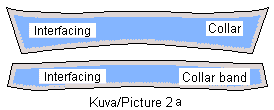
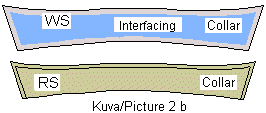
Turn button extensions right side out. Iron and sew
along folded seam allowances (Picture 1).
Iron interfacing to both collar and collar stand pieces
(Picture 2a).
Sew round the collar, cut corners of seam allowances and
turn the collar right side out. Iron and edgestitch along the outer edge
of the collar (Picture 2b).
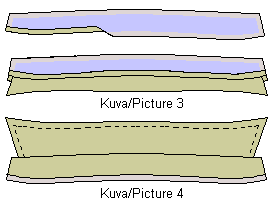
Fold seam allowance of one collar stand to the wrong side,
baste and iron. Sandwich collar between the collar stand pieces raw edges
matching and sew through all thicknesses (Picture 3). Cut the corners
of the seam allowance and turn the collar to its right position (Picture
4). Iron.
Place the right side of the collar stand (with the unfolded
seam allowance) against the wrong side of the blouse neck and attach the
collar to the blouse neck opening. Turn seam allowances inside the collar.
Pin the other edge of the collar stand (with the folded seam allowance)
to its final position and sew near edge of the folded seam allowance.
Sew buttons and buttonholes on the CF-line of the button
extension and the collar stand.

Another technique
Another way to attach the collar is described in the drawing
to the left (Picture 5).
Fold the button extension of the blouse right side against
right side. Unlike in the instructions above, do not fold the seam allowance
of the collar stand. Sandwich collar between the folded button extension
and the blouse . Sew the collar stand to the neck opening of the blouse.
Overlock the seam allowance with seamster or with zigzag.
Stitch button extensions across bottom edges. Turn button
extensions and collar out and sew along folded seam allowance edge.
This technique of sewing the collar to the neck opening
is not as neat as when sewing the seam allowance inside the seam. Usually
the inside of the garment neck is, however, not in sight, so it does not
matter.
Sew buttons and buttonholes on the CF-line of the button
extension and the collar stand.
 A
third technique worth while trying A
third technique worth while trying
Fold and sew button extension according to above instructions.
Prepare the collar and sandwich it inside the collar stand
pieces as above. Leave raw edges of collar stand flat. Place right side
of the collar stand to the wrong side of the neckline raw edges even.
Sew along the neckline (Picture 6a).
Fold collar stand pieces right side against right side
encasing collar and neckline edge inside. Sew along raw edges for distance
of about 2.5-5 cm / 1-2" from the end of the collar stand (Picture
6b).
Trim seam allowance to reduce bulk at the end of the collar
stand. Then turn the collar and the collar stand right side out. Fold
the rest of the seam allowance of the collar stand in and topstitch along
the outer edge of the collar stand.
Sewing and attaching a blouse collar

For the collar, cut 2 pieces of fabric and 1 piece of interfacing.
Iron interfacing to under collar. The under collar piece is
on the inside, hidden by the upper piece, when the garment is completed.
Fold button placket inwards along fold line and sew along
bottom and top ends from fold line to front center. Cut seam allowances
diagonally at point where seam ends, so that button placket can be turned
right side out.
Turn bottom seam allowance of under collar inside, baste
and iron (Picture, a). Place collar pieces with right sides together
and sew along edges (Picture, b).Trim seam allowances and cut corners.
Turn right side out. Sew raw edge of upper collar to shell's neck
from front center to front center, collar's right side against blouse's
wring side. Press seam allowance upwards and pin basted edge of
under collar on top of previous seam. Sew. Edgestitch if wanted.
Sewing and attaching a hood

The hood piece in the pattern makes one half of the hood.
Cut 4 pieces, 2 of garment fabric and 2 of lining fabric. The lining
pieces can also be of same or similar fabric, if desired.
The openings for the drawstring are sewn like small buttonholes at right
side of hood 3/4 inch (2 cm) from front edge and 1 1/2 inches (4
cm) from bottom edge (Picture 1a ). To strengthen button holes,
iron interfacing to wrong side of fabric before sewing button holes.
Sew both outer pieces together, right sides together (Picture
1b). Do the same with the lining pieces. Snip the seam allowance
along the curved section at back of hood at intervals of about 3/4
inch or 2 cm (Picture 2).
Turn neck seam allowance of hood lining inwards and baste.
Place lining and hood right sides together and sew along front edges (Picture
3 ). Turn hood right side out.
Sew hood to neck of shell,right sides together, from center
front to center front. Press seam upwards and pin the basted edge
of hood lining onto seam. Sew near edge.
Sew a 3/4 inch (2 cm) wide tube for strings at front edge
(Picture 4).
Sewing and attaching cuffs to sleeves


Iron interfacing on sleeve cuffs. Fold seam allowance to
the wrong side at one long edge of the cuff. Baste and iron. Fold the
cuff pieces horizontally into two. Sew along short edges. Cut corners
of the seam allowances and turn the cuffs right sides out. Iron.
Fold in seam allowance of one long edge of sleeve cuff
and baste (Picture 1).
 Fold
cuffs horizontally in two, right sides inside, and sew along ends (Picture
2 ). Note that seam allowance of one edge has been folded in, but
the other is unfolded, so the edges don't meet. Cut seam allowance
diagonally at corners and turn cuffs right side out. Fold
cuffs horizontally in two, right sides inside, and sew along ends (Picture
2 ). Note that seam allowance of one edge has been folded in, but
the other is unfolded, so the edges don't meet. Cut seam allowance
diagonally at corners and turn cuffs right side out.
Cut slits at ends of sleeves and overlock edges.
Turn seam allowances inside and edgestitch on right side (Picture 3).
Fold slit with right side inside and sew a small triangle at the bottom
of the slit (Picture 4).
Fold ease of sleeve ends into soft pleats near split.
Sew raw edges of cuffs to sleeve ends with right side of cuff against
wrong side of sleeve. Turn seam allowance inside cuffs and press.
Pin basted edge of cuff onto previous seam and edgestitch from right side.
Sew buttonholes. Sew on buttons.
Another technique: sewing a bound slit
Bound slit is best suited to sleeve hems but it can also
be used to sew a slit to front or back neck opening, or to side slits
of tunic hem.
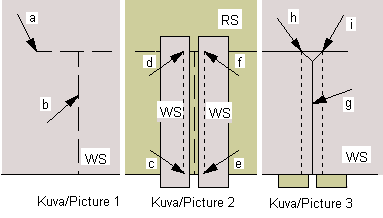
Mark the height of the slit to the wrong side of the garment
with pencil (Picture 1 a and b). Machine baste along the lines to transfer
the markings to the right side of the garment.
Cut two bias strips of fabric three times as wide as you
want the binding strips of the slit to be. Place them on both sides of
the machine basted line right side under to the right side of the garment
0.3 cm / 1/8" from the line (Picture 2).
Sew 0.7 cm / 1/4" from the basted vertical line (Picture
2, c-d and e-f).
Cut an opening along the basted line (Picture 3g) and diagonally
at the corners (Picture 3h and i). Be careful not to cut the binding strips.

Press the binding strips and the seam allowances toward
the slit. Turn 1/3 of the long edges of the binding strips in and wrap
the bindings around the raw edges of the slit (Picture 4).
Fold back the wrong side of the garment to expose the triangle
at the end of the slit opening and sew across the end to the slit catching
both binding strips (Picture 5j-k).
Do final ironing and attach cuffs or collar or whatever
you need to attach to this place of your garment.
Third sewing technique: cuff placket with overlap (shirt
placket)
 Shirt
placket is finished with two separate pieces of fabric to create a wider
lap. Shirt
placket is finished with two separate pieces of fabric to create a wider
lap.
First construct the underlap. Cut a 8 x 10 cm piece of fabric
(picture 1). Fold the piece into two as in the picture, right side out.
Fold one vertical seam allowance (1 cm) in and press (picture 2).
Then make the overlap. Cut 8 x 10 cm piece fabric (picture
3). Fold the piece into two wrong side out. Sew along top as in picture
4. Trim seam allowance and turn overlap right side out. Fold one vertical
seam allowance (1 cm) in and press.

Mark placket on the right side of the sleeve cuff (picture
6).


Pin underlap on the left side of marked placket and overlap
on the right side of the placket as in picture 7. Edges meet at the center
of the placket. Sew along the marked vertical sides of the placket, stop
at corners.
Cut along the center of the placket and vertically at the
top corners as in picture 8. Fold and press seam allowances inside underlap
and overlap and the top triangular piece to the wrong side of the sleeve
upwards.

Fold laps to right position, underlap to the wrong side
of the sleeve cuff and overlap to the right side of the sleeve cuff and
edgestitch laps from the right side (picture 9). Topstitch the top part
of the overlap through all thicknesses
Sewing pockets

There are darts at the upper part of the pocket bag and
lining of pants. There are similar darts at the pants' waist.
HINT : If wanted, the darts can be moved from the top to the bottom
of the pocket pieces. Cut the pocket patterns vertically from the dart
apex to and across the bottom edge of the pocket pieces ( picture, a)
and pivot the pieces to close the darts at the top edge of the pockets
(picture, b) and to open them at the bottom edge of the pockets.
Patch pockets

Cut the pocket pieces according to Picture 1: Pocket height
is marked in the picture. Add 5 cm/2" of height to the pocket pattern
for self-facing and iron interfacing to it as in the picture. This part
of the pocket top will be turned inside when the pocket is complete. If
the fabric is very thin or elastic, iron interfacing to wrong side of
whole pocket. Always trim interfacing to eliminate the seam allowance
to avoid bulk.
Cut pocket lining 10cm/4" lower than the pocket piece.
Cut the lining pieces also otherwise slightly smaller (0.3cm / 1/8")
than the pocket piece so that the seams will not show when the pockets
are complete. When sewing the lining to the pocket seams, slightly stretch
the lining.
 Sew
lining to the top of the pocket piece as in picture 2 leaving an opening
for turning the pocket (picture 2 a-b). Fold pocket and lining right sides
together raw edges matching and sew along sides and bottom. Notch seam
allowances at intervals of about 1cm / 1/2" at the rounded curves
of the pocket and trim corners diagonally. Turn the pocket right side
out and slip stitch the opening closed. Sew
lining to the top of the pocket piece as in picture 2 leaving an opening
for turning the pocket (picture 2 a-b). Fold pocket and lining right sides
together raw edges matching and sew along sides and bottom. Notch seam
allowances at intervals of about 1cm / 1/2" at the rounded curves
of the pocket and trim corners diagonally. Turn the pocket right side
out and slip stitch the opening closed.
Topstitch pocket mouth at a distance of 4cm / 1 1/2"
from the top edge (Picture 3a).
Attach the pockets to the garment.
HINT : Machine baste the pockets in place diagonally from corner
to corner (Picture 3b). When sewing the pocket to the garment push the
pocket away from the seam and stitch along the edges of the lining. That
way the seam does not show on the right side when the pocket has been
sewn to the garment.
Pocket with flap
 
NOTE: The method used here to attach flap, welt
and buttonhole pockets is called
windowpane opening method. It is one of the easiest ways to sew
this kind of pockets successfully.
Cut 4 pieces of pocket flaps. Iron interfacing to two of them. Sew flaps
two and two together right sides inside along sides and bottom edges.
Notch seam allowances at intervals of about 1 cm / 1/2 " at the bottom
curves. Turn flaps right sides out, open seams well, iron and edgestitch
along sides and bottom.

Mark the the pocket opening to the wrong side of the garment
with pen. Machine baste along the marked lines to transfer the marking
to the right side of the garment (Picture 2 a). Iron a 5cm/2" wide
strip of interfacing to the wrong side of the garment at the pocket opening
line.
Place pocket flap upside down raw edges along the pocket
opening line (Picture 2 b).
Cut 2 copies of pocket bag (garment fabric) and 2 copies
of pocket linings (lining fabric) 10cm/4" wider than the pocket opening
and two times as high as you want to pocket to be. Pin pocket bag upwards
right side against right side on the pocket mouth line and the lining
downwards right side against on top of the pocket flap on the pocket mouth
as in
picture 3 and sew a rectangle around the pocket mouth line (Picture
3 a).
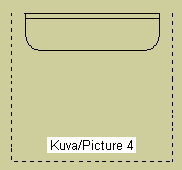
Cut through center of rectangle and diagonally at the ends
(Picture 3 b). Cut only the garment fabric, do not cut the flap.
Turn the pocket bag, the lining and the flap through the
opening to the wrong side of the garment and finger press the seams well.
On wrong side of the garment Understitch the seams of the opening, first
the long sides and then the short sides.
Press the rectangle area from the wrong side. Turn the
pocket bag downwards edges matching the lining. Sew and overlock sides
and bottom of the pocket bag.
Turn the flap to its correct position and topstitch at
width of presser foot from the top of the flap (Picture 4).
 Pocket
with welt Pocket
with welt
Sew pocket with welt according to instructions for pocket
with flap. Place the welt, however, upside down from the pocket opening
line downwards (Picture 1a) and turn it upwards when ready (Picture 2
).
Buttonhole pockets (Bound pockets)
Cut two pieces of pocket bags from garment fabric and two
pieces of pocket linings from lining fabric. Mark the pocket opening to
the wrong side of the garment with pen.
Pin pocket lining on the garment (Picture 1a). Sew a rectangle
around the opening line on the wrong side. Cut through center of rectangle
and diagonally at the ends (Picture 1b ).

Turn the lining through the opening to the wrong side of
the garment and finger press the seams well. On wrong side of the garment
understitch the seams of the opening, first the long sides and then the
short sides (Picture 2).
Cut 4 pieces of pocket binding strips. Iron interfacing
to the wrong sides of them. Fold them lengthwise in two (Picture 3a) and
zigzag two and two together like in the picture (Picture 3b).

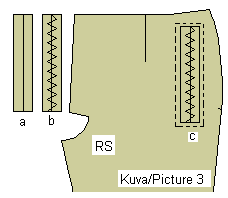 Place
the binding strips under the pocket opening rectangle and edge stitch
along the edges of the rectangle. (Picture 3c). Press the rectangle and
the binding strips from wrong side. Place
the binding strips under the pocket opening rectangle and edge stitch
along the edges of the rectangle. (Picture 3c). Press the rectangle and
the binding strips from wrong side.
HINT : Try fuse-basting to keep the pocket binding strips in place
when you sew around the rectangle. Fuse-basting is
explained above
.

Place pocket bag under the pocket lining raw edges matching.
Sew and overlock bottom edges of the pocket (Picture 4a).Pin sides (Picture
4a) and center front (Picture 4c) of the pocket. These will be attached
to side and zipper seams later. Unravel the zigzag stitches from the pocket
binding strings and do the final pressing.
HINT : There is a handy device for sewing buttonhole (double welt)
pockets. Clotilde's sewing notions catalog offers a Double Welt Pocket
Maker. It is fairly simple to use and with it it's easy to sew narrow
and even welts for double welt pocket. I bought mine in a Fabric shop
in Seattle - the name of which I have forgotten - but as far as I remember
it correctly the price for this device was about US$ 30.

The device is sold with clear instructions.
Hip pockets
Cut the pocket corner off the pants front piece (Picture
1) Cut two pieces of pocket bags and two pieces of pocket linings. Place
pocket lining on the right side of the front piece pocket mouths matching.
Sew along pocket mouth(Picture 2), turn pocket lining to the wrong side
of the garment (Picture 3) and iron.
Edgestitch pocket mouth (Picture 4). Place pocket bag under
pocket lining raw edges matching. Sew and overlock the bottom edges of
the pockets (Picture 5a). Pin side (Picture 4b) and CF-edges (Picture
5c) of the pocket to the garment. These edges will be attached to garment
seams when sewn.



Side pockets
Cut 2 copies of pocket bags from garment fabric and 2 copies
of pocket lining from lining fabric pieces for pockets.
Place pocket lining piece on the garment, right sides together.
Sew along pocket mouth (Picture 1a-b). Cut seam allowance at the
ends of pocket mouth. Turn pocket lining to the wrong side of the
garment and topstitch pocket mouth Picture 2).

Place pocket bag piece under the pocket lining raw edges
matching (Picture 3). Sew and overlock along the curved outer edges.
Pocket back piece is attached to side seam when sides are sewn.
Use care not to catch the finished edge of pocket mouth in the side seam.
Press the pocket toward the front of the garment and side
seams toward the back. If you want to create a very durable pocket mouth
for this kind o a pocket, bartack both ends of the pocket opening.
Terminology used
 Edgestitching Edgestitching
Edgestitching is used to finish the garment edges, such
as edges of collars, jacket lapels, shirt button plackets etc. Change
a straight stitch for edgestitching foot to your sewing machine and sew
near the folded edge or seamline. Use 3-4 mm stitch length. Long stitch
length looks better than short. If you do not have an edgestitch foot,
use a zigzag foot and reset the needle so it is on the extreme right-hand
side.
Topstitching
Topstitching is used to strengthening or embellishing garments
details such as pocket mouths, facings, princess seams etc..
HINT: If you want the topstitching to have a padded or quilted
look, try sandwiching a layer of flannel or fleece between the garment
and the facing.
HINT : In some couture sewing books it
is recommended that the top stitching is completed early in the construction
process i.e. before facings and linings are applied. In that way there
is less bulk and fewer layers of fabric to control. This is worth trying.
HINT: If you want to emphasize the lines
of topstitching or edgestitching, sew with two threads in the needle
or with twin-needle.
 Understitching Understitching
Understitching is a single line of stitching to seam allowance
close to the seam line preventing facings and linings from rolling to
the outside of a garment.
After having sewn the facing or the lining to your garment,
grade and clip the seam allowances with the garment's allowance wider
than the facing's, then press the allowances to lie flat toward the lining
or the facing. On the facing straight-stitch close to the seamline through
all thicknesses. Use your fingertips to feel along the seamline in front
of the presser foot to ensure that the seam allowances lie flat and to
one side.
Understitching is good idea to be applied when sewing a
window pane pocket openings. Understitching the pocket facing makes the
opening crisp and accurate.
Easestitching
Easestitching is used in seams where the edges to be joined
are not equally long. This kind of a situation is e.g. easing the sleeve
cap to fit to the armscye. Sew easestitching with distance of seam allowance
from the edge i.e. along the seam line. Sew easestitching using the 4-5
mm stitch length i.e. long but not the longest possible. You notice that
the fabric is automatically eased as you sew. You can intensify the easing
by tightening the strain of the upper thread of the sewing machine.
Usually the waist band is somewhat shorter than the waist
of the garment. Sew easestitching to the garment waist before attaching
the waist band to it. Sew the easestitching with distance of seam allowance
from the edge i.e. along the seam line. If the garment has a lining, sew
the easestitching through the garment and the lining.
Easestitching can also be used to join seams which curve
to different directions e.g. the princess seams of the bodice. Sew easestitching
to one of the seams with distance of seam allowance from the edge. Place
the pieces together and sew along the easestitch.
Easestitching can also make it easier to attach a collar
to the neck opening of the garment. Sew easestitching with distance of
seam allowance from the edge to the neck opening of the garment. Place
the collar and the garment together and sew along the easestitch.
| ![]() Site
Map
Site
Map


 Here
is an easy way to sew a professional looking bound edges to neck
openings, sleeve cuffs and hems of casual garments as well as to lingerie
and outdoor garments. In the example illustrated here the edging is sewn
to the neck opening of a sweater
Here
is an easy way to sew a professional looking bound edges to neck
openings, sleeve cuffs and hems of casual garments as well as to lingerie
and outdoor garments. In the example illustrated here the edging is sewn
to the neck opening of a sweater Fold
the fabric strip lengthwise in two, wrong side inside, and iron. Sew it
to the wrong side of the neck opening raw edges matching. Stretch
the edging a bit when sewing.
Fold
the fabric strip lengthwise in two, wrong side inside, and iron. Sew it
to the wrong side of the neck opening raw edges matching. Stretch
the edging a bit when sewing. 
 Trim
seam allowance to half. Open the seam well by iron the edging and the
seam allowances away from each other. Turn the edging around the edge
to the right side of the garment along the stitch line. Be sure not to
leave the stitch line visible at the right side of the garment. Edgestitch
along the folded edge. Sew slowly. Only even edgings with straight stitch
lines are neat.
Trim
seam allowance to half. Open the seam well by iron the edging and the
seam allowances away from each other. Turn the edging around the edge
to the right side of the garment along the stitch line. Be sure not to
leave the stitch line visible at the right side of the garment. Edgestitch
along the folded edge. Sew slowly. Only even edgings with straight stitch
lines are neat.










 Sewing a button placket
Sewing a button placket  Iron
interfacing to the wrong side of the neck facing and sew the shoulder
seams of the facing.
Iron
interfacing to the wrong side of the neck facing and sew the shoulder
seams of the facing. 




 A
third technique worth while trying
A
third technique worth while trying



 Fold
cuffs horizontally in two, right sides inside, and sew along ends (Picture
2 ). Note that seam allowance of one edge has been folded in, but
the other is unfolded, so the edges don't meet. Cut seam allowance
diagonally at corners and turn cuffs right side out.
Fold
cuffs horizontally in two, right sides inside, and sew along ends (Picture
2 ). Note that seam allowance of one edge has been folded in, but
the other is unfolded, so the edges don't meet. Cut seam allowance
diagonally at corners and turn cuffs right side out. 

 Shirt
placket is finished with two separate pieces of fabric to create a wider
lap.
Shirt
placket is finished with two separate pieces of fabric to create a wider
lap.





 Sew
lining to the top of the pocket piece as in picture 2 leaving an opening
for turning the pocket (picture 2 a-b). Fold pocket and lining right sides
together raw edges matching and sew along sides and bottom. Notch seam
allowances at intervals of about 1cm / 1/2" at the rounded curves
of the pocket and trim corners diagonally. Turn the pocket right side
out and slip stitch the opening closed.
Sew
lining to the top of the pocket piece as in picture 2 leaving an opening
for turning the pocket (picture 2 a-b). Fold pocket and lining right sides
together raw edges matching and sew along sides and bottom. Notch seam
allowances at intervals of about 1cm / 1/2" at the rounded curves
of the pocket and trim corners diagonally. Turn the pocket right side
out and slip stitch the opening closed. 



 Pocket
with welt
Pocket
with welt

 Place
the binding strips under the pocket opening rectangle and edge stitch
along the edges of the rectangle. (Picture 3c). Press the rectangle and
the binding strips from wrong side.
Place
the binding strips under the pocket opening rectangle and edge stitch
along the edges of the rectangle. (Picture 3c). Press the rectangle and
the binding strips from wrong side. 





 Edgestitching
Edgestitching
 Understitching
Understitching